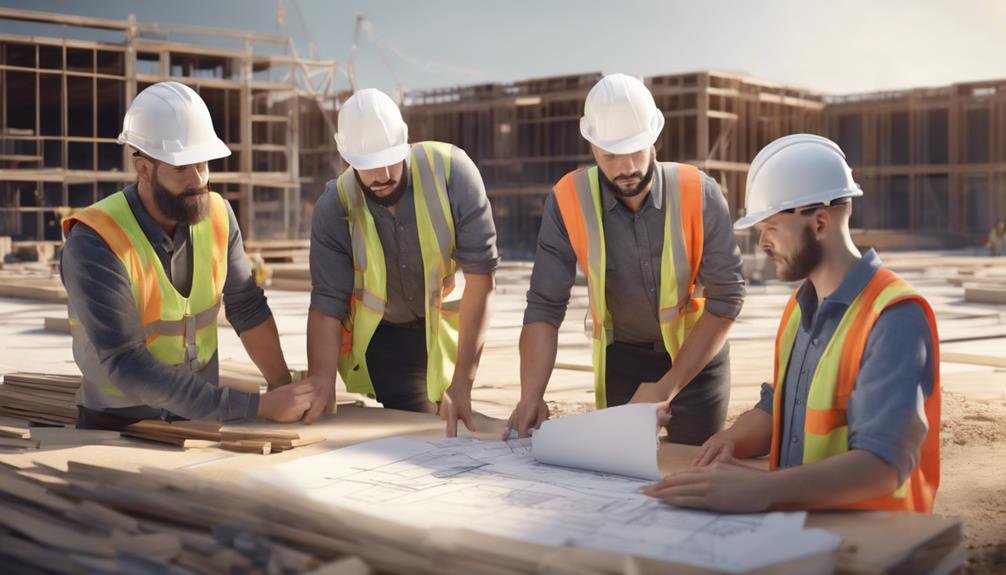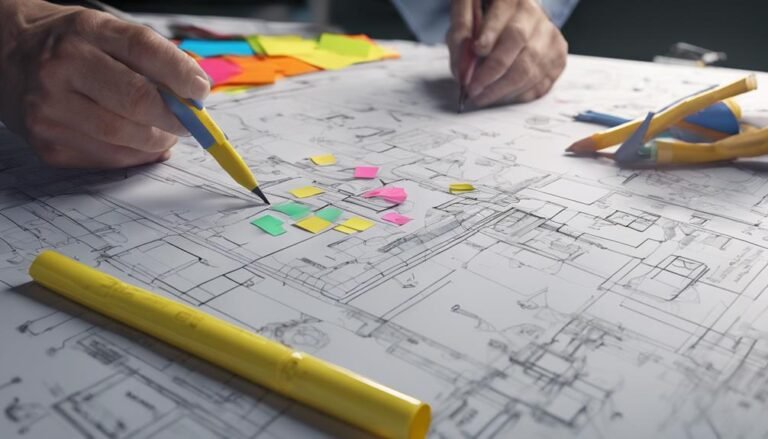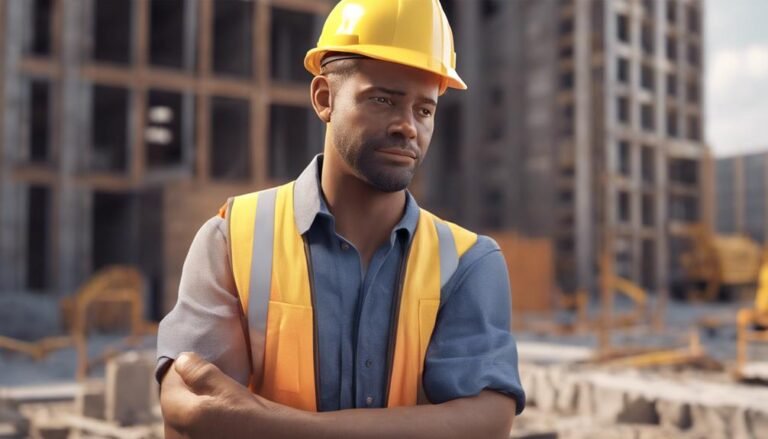Conflict Resolution Strategies for Construction Teams
When managing conflicts in construction teams, prioritize clear and direct communication. Listen actively, de-escalate tensions, and use emotional intelligence to navigate challenges. Setting expectations, roles, and boundaries helps prevent misunderstandings. Embrace diversity through training and team building activities to strengthen bonds. Utilize mediation techniques when conflicts arise, seeking win-win solutions benefit all. Leverage technology and external support when necessary. These strategies foster teamwork, open dialogue, and constructive problem-solving for successful projects and harmonious environments.
Key Takeaways
- Clear communication is essential for resolving conflicts effectively.
- Establishing clear expectations and boundaries prevents misunderstandings.
- Embrace diversity and inclusion through cultural sensitivity training.
- Implement team building activities to enhance collaboration and trust.
- Seek win-win solutions through open dialogue and negotiation.
Importance of Conflict Resolution
Understanding the significance of conflict resolution is essential for fostering a productive and harmonious work environment within a construction team. Conflict resolution impact on team dynamics can't be overstated. When conflicts are managed effectively, it can lead to improved collaboration, trust, and overall team cohesion. Constructive conflict management plays a critical role in determining project success. By addressing conflicts in a proactive and positive manner, construction teams can navigate challenges more efficiently, leading to better outcomes and higher levels of satisfaction among team members.
Conflicts, if left unresolved, can escalate and create tension within the team, hindering progress and causing delays. This can ultimately impact the quality of work and the overall success of the project. By implementing effective conflict resolution strategies, construction teams can't only prevent conflicts from escalating but also turn them into opportunities for growth and innovation. Embracing conflict resolution as a cornerstone of team dynamics is key to achieving project success in the construction industry.
Effective Communication Strategies
To effectively address conflicts and enhance team collaboration within a construction team, implementing clear and direct communication strategies is essential. Active listening plays a vital role in effective communication within a construction team. By actively listening to your team members, you demonstrate respect and understanding, which can help prevent misunderstandings and conflicts.
Additionally, conflict de-escalation techniques are indispensable for resolving issues peacefully. Being able to identify escalating conflicts and address them promptly can prevent small disagreements from turning into larger disputes.
Emotional intelligence is another key component of effective communication. Understanding your emotions and those of your team members can help you navigate challenging situations with empathy and composure. By practicing assertive communication, you can express your thoughts and feelings clearly while still respecting the opinions of others. This approach fosters open dialogue and encourages constructive problem-solving within the team.
Establishing Clear Expectations
Establishing clear expectations within your construction team is a foundational step towards guaranteeing smooth project execution and minimizing misunderstandings. Setting boundaries and managing expectations upfront can prevent conflicts that may arise due to differing interpretations or assumptions. Clearly define roles, responsibilities, deadlines, and quality standards for each team member to create a shared understanding of what's expected. Make sure to communicate these expectations effectively, ensuring that everyone is on the same page from the beginning.
When setting boundaries, be explicit about what's and isn't acceptable behavior within the team. This can help prevent potential conflicts stemming from misunderstandings or differing perspectives on appropriate conduct. By establishing clear guidelines for communication, decision-making processes, and conflict resolution procedures, you can create a more cohesive and harmonious work environment. Regularly revisit and reinforce these expectations to ensure that they remain top of mind for all team members throughout the project. Remember, clear expectations lead to smoother collaboration and successful project outcomes.
Embracing Diversity and Inclusion
When it comes to embracing diversity and inclusion within your construction team, consider implementing cultural sensitivity training to foster understanding and respect among team members.
Engaging in team building activities can help strengthen bonds and create a more cohesive work environment.
Keeping open communication channels allows for the sharing of ideas and concerns, promoting a culture of inclusivity and collaboration.
Cultural Sensitivity Training
Implementing cultural sensitivity training in construction teams enhances teamwork and fosters a more inclusive work environment. This training equips team members with the necessary skills to navigate cross-cultural collaboration, leading to better conflict resolution.
By increasing awareness of different cultural perspectives and communication styles, sensitivity training helps improve team dynamics. It promotes respect for diverse backgrounds and encourages open dialogue, reducing misunderstandings and potential conflicts.
Embracing diversity through cultural sensitivity training not only enhances the overall work environment but also boosts productivity and creativity within the team. This proactive approach prepares construction teams to effectively address any cultural differences that may arise, fostering a more harmonious and successful project completion.
Team Building Activities
To further enhance team cohesion and foster an inclusive work environment in construction teams, engaging in team building activities that embrace diversity and inclusion is paramount. Consider the following activities:
- Trust exercises: Build trust within your team through activities that require individuals to rely on each other.
- Problem-solving challenges: Encourage collaboration and critical thinking by engaging in challenging tasks that require innovative solutions.
- Outdoor retreats: Take your team out of the office environment to relax and bond in a different setting.
- Team bonding exercises: Strengthen relationships and communication among team members through fun and interactive activities.
These activities can help create a more united and supportive construction team that values diversity and inclusion.
Open Communication Channels
Regularly maintaining open communication channels within your construction team is essential for embracing diversity and inclusion.
Active listening plays a pivotal role in fostering understanding among team members with diverse backgrounds and experiences. By actively listening to each other, you demonstrate respect for differing viewpoints and create a space where all team members feel valued.
Team collaboration is also enhanced through open communication channels, allowing for the sharing of ideas and perspectives that contribute to innovative solutions and effective problem-solving. Conflict resolution becomes more manageable when team members feel comfortable expressing their concerns openly, leading to the building of trust within the team.
Embracing open communication channels not only promotes diversity and inclusion but also strengthens the overall cohesion and productivity of your construction team.
Utilizing Mediation Techniques
How can mediation techniques be effectively employed to resolve conflicts within a construction team?
When conflicts arise among team members, utilizing mediation techniques can help in finding amicable solutions and maintaining a harmonious work environment.
Here are some strategies to effectively implement mediation techniques:
- Neutral Third Party: Bringing in a neutral mediator can help facilitate discussions and make sure that both parties feel heard and understood.
- Active Listening: Encouraging active listening during mediation sessions can help team members truly understand each other's perspectives and foster empathy.
- Collaborative Problem-Solving: Encouraging team members to work together to find solutions rather than placing blame can lead to more sustainable resolutions.
- Establishing Ground Rules: Setting clear ground rules for the mediation process can help maintain a respectful and constructive environment for resolving conflicts.
Implementing Team Building Activities
When looking to strengthen team dynamics and foster a more cohesive work environment, incorporating team building activities can greatly enhance collaboration and communication within a construction team.
Trust exercises and icebreakers are excellent ways to break down barriers and build trust among team members. These activities create a sense of camaraderie and help team members feel more comfortable working together.
Problem-solving challenges are another effective team-building activity that can improve critical thinking skills and encourage teamwork. By working together to overcome obstacles, team members learn to communicate more effectively and leverage each other's strengths.
Outdoor activities, such as team sports or ropes courses, can also promote teamwork and boost morale. Engaging in these activities outside of the usual work environment can lead to better relationships and improved collaboration back on the construction site.
Resolving Conflicts Through Negotiation
When resolving conflicts through negotiation,
it's essential to open communication channels to foster understanding.
Identifying mutual interests
can help parties find common ground to build upon.
Seeking win-win solutions
guarantees that all involved parties benefit from the resolution.
Open Communication Channels
To effectively resolve conflicts within a construction team, open communication channels play a crucial role in facilitating negotiation and reaching mutually beneficial solutions. When dealing with conflicts, consider the following strategies:
- Active Listening: Encourage team members to listen attentively to each other without interrupting.
- Constructive Feedback: Provide feedback that's specific, respectful, and focuses on improvement.
- Regular Check-ins: Schedule regular meetings to discuss progress, address concerns, and guarantee everyone is on the same page.
- Transparency: Foster an environment where team members feel comfortable expressing their thoughts and concerns openly.
Identify Mutual Interests
Identifying mutual interests is key to successfully resolving conflicts through negotiation within a construction team. By identifying common goals, you can pinpoint areas where team members' interests align, fostering a sense of collaboration and shared purpose.
This process not only helps in understanding each other's perspectives but also lays the foundation for building trust relations. When team members recognize that they've similar objectives, it becomes easier to find mutually beneficial solutions to disagreements.
Building trust relations through the identification of mutual interests creates a positive environment for constructive dialogue and problem-solving. Encouraging open discussions centered around common goals can lead to more effective conflict resolution within the construction team.
Seek Win-Win Solutions
To effectively resolve conflicts within a construction team through negotiation, the focus should be on seeking win-win solutions that cater to the interests of all involved parties.
When aiming for win-win outcomes, consider engaging in collaborative brainstorming sessions and participating in conflict resolution workshops. These activities can help foster a positive environment for resolving differences and finding mutually beneficial solutions.
By encouraging open communication and active listening during negotiations, team members can work together to address concerns effectively.
Leveraging Technology Solutions
Leveraging technology solutions can streamline communication and enhance collaboration within construction teams. By integrating various tech tools and online platforms, teams can effectively resolve conflicts and improve overall productivity. Virtual conflict resolution becomes more manageable with the right technology at hand. Here is a table showcasing some common technology solutions that can aid in conflict resolution and team collaboration:
| Technology Solution | Description |
|---|---|
| Project Management Software | Tools like Asana or Trello help in task allocation and tracking progress. |
| Communication Apps | Platforms like Slack or Microsoft Teams facilitate real-time communication. |
| Virtual Meeting Software | Applications such as Zoom or Google Meet enable virtual face-to-face discussions. |
These tools offer a structured approach to conflict resolution, providing a centralized platform for discussions and decision-making. By leveraging technology solutions effectively, construction teams can mitigate conflicts efficiently and foster a more cohesive working environment.
Seeking External Support When Needed
When is it appropriate for construction teams to seek external support to address conflicts effectively? In the construction industry, conflicts can arise due to various reasons, and seeking external support can sometimes be essential in resolving these disputes. Here are some key strategies for construction teams to take into account when looking for external support:
- External resources: Utilize external resources such as conflict coaching to provide team members with the necessary skills to manage and resolve conflicts effectively.
- Professional mediators: Engage professional mediators who are trained in conflict resolution techniques to facilitate discussions and help parties reach mutually agreeable solutions.
- Third-party facilitators: Consider bringing in third-party facilitators who can provide an unbiased perspective and guide the construction team towards a resolution that's fair and acceptable to all parties involved.
Conclusion
Just as a skilled painter blends different colors on a canvas to create a masterpiece, construction teams must navigate conflicts with finesse and collaboration.
By embracing effective communication, setting clear expectations, and utilizing mediation techniques, teams can work together harmoniously like a well-coordinated orchestra.
Remember, conflicts are just temporary roadblocks on the path to a successful project.
With the right strategies in place, your construction team can overcome any challenge and build something truly remarkable.







